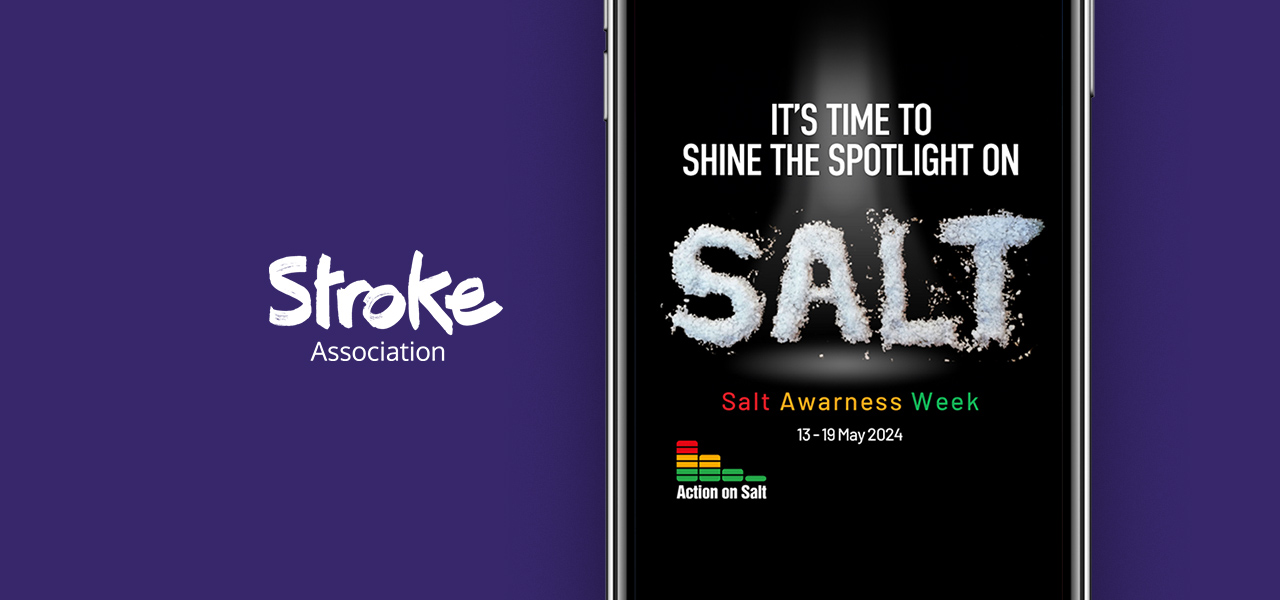15 May 2024

Shining the spotlight on salt – to reduce our risk of stroke
The advice that everyone gives is always ‘eat less salt’, but do you know why?
If we eat too much salt, we can develop hypertension, or ‘high blood pressure’, which in turn is a big cause of strokes and heart attacks.
We need a little bit of salt to keep our bodies running properly; this is because salt helps our bodies to store water. Some people, like athletes, need more salt, because their bodies need to take on more water for exercise and sweating. But even top-class athletes only need a tiny bit more salt.
The rest of us don’t need much at all. A good rule of thumb is the ‘Stick with 6’ – meaning we generally only need 6g per day – about one level teaspoon. When we eat more than this, our bodies can’t stop taking on water.
Salt helps our body regulate how much water it has in it. When we eat more salt than necessary or too much salt our body stores more water. More water in our blood vessels increases our blood pressure.
When your body needs to flush out salt, it will find water wherever it can. It will take water from what we drink and what we eat, and it won’t let the water out in the normal ways (aka going to the toilet or sweating), so we can’t just cut down on water intake to lower our blood pressure, unfortunately!
High blood pressure is the single biggest risk factor for stroke and half of people having a stroke have it. It can make blood clots form, which then travel to the brain, block off blood flow entirely and cause the brain to start to die. Or the pressure itself can cause blood vessels to burst.
This Salt Awareness Week (13-19 May 2024), the Stroke Association is working with LoSalt to raise awareness that a diet high in salt can raise your blood pressure, which is the single biggest risk factor for stroke.
Ideally, everyone should cut down on salt (it’s very easy to exceed the 6g without adding any salt to your food!). We know that salting is a habit that is hard to break. If that’s the case, then it’s good to know that LoSalt provides an alternative to regular salt.
With 66% less sodium than regular table salt, sea salts and rock salts, switching to LoSalt can help maintain normal blood pressure without sacrificing flavour. We are delighted to partner with LoSalt®, the UK’s leading reduced sodium salt alternative.
Other tips to help cut down on salt include:
- Remember the maximum daily intake recommended for adults is just one teaspoon of salt (or 6g)
- Flavour meals with garlic, chilli, herbs, spices, lemon or lime juice, or use LoSalt as an alternative to regular salt
- Make your own sauces, pickles or chutney to control how much salt goes in
- Choose tinned fish in spring water instead of brine
- Beware of added salt in foods like:
- Bread, which can have as much salt in one slice as a packet of crisps and can provide up to 20% of your daily salt intake
- Breakfast cereals like cornflakes, which can be high in salt
- Crisps, salted nuts and other salty snacks
- Cheese, butter and margarine
- Processed meat like bacon and sausages
- Ready-meals and soups
- Baked beans and ready-made pasta sauces
- Tomato ketchup and other sauces
- Pickled foods
If you take some types of post-stroke medication that affect potassium levels, LoSalt® and other reduced sodium salt alternatives may not be suitable for you. Check with your GP for advice.
